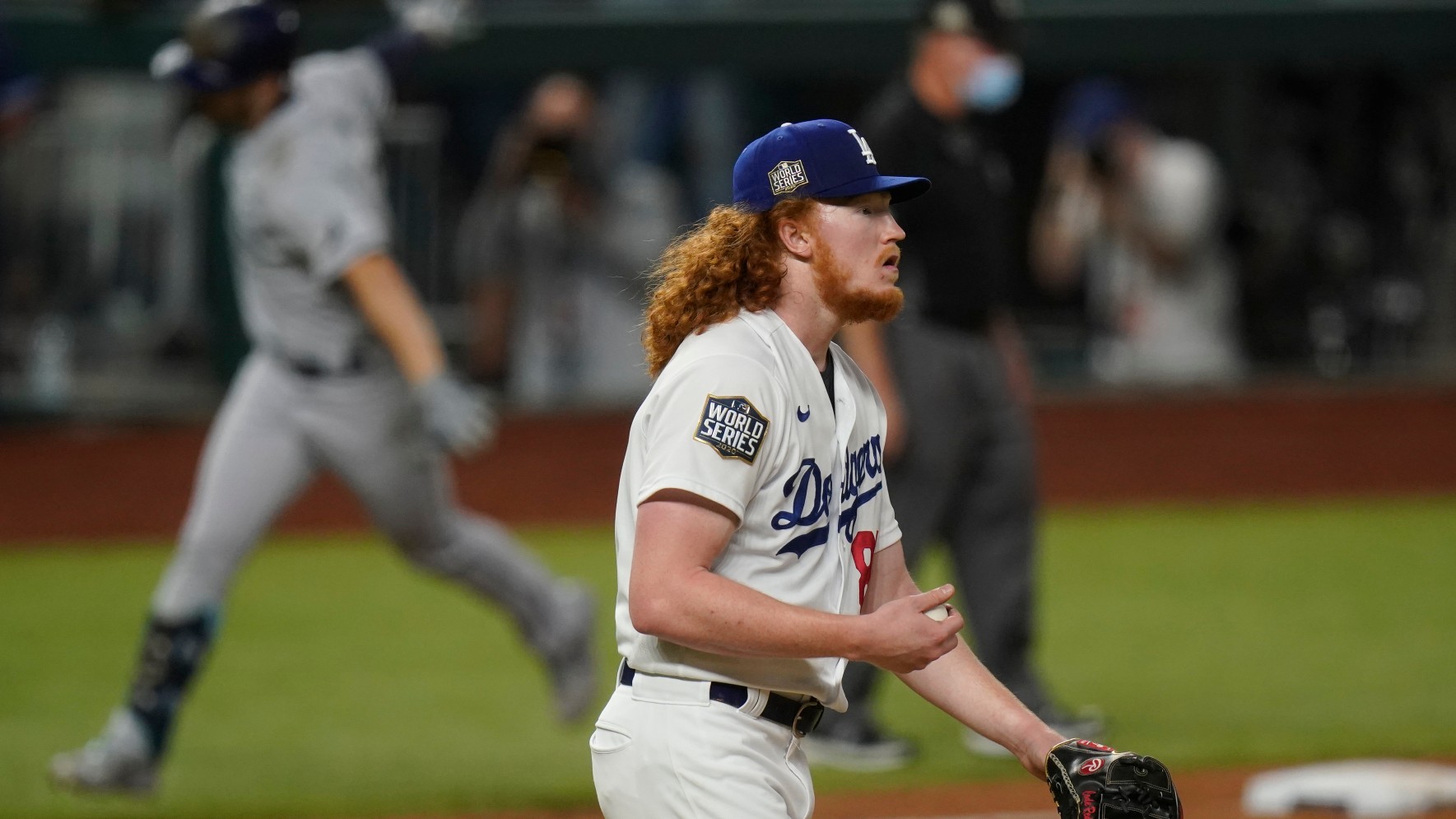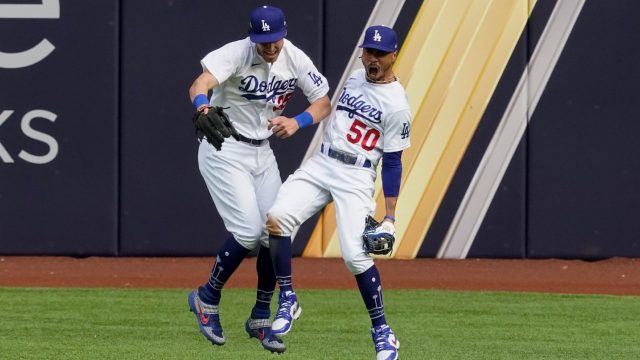
The Tampa Bay Rays beat the Los Angeles Dodgers Wednesday, 6-4, in Game 2 of a World Series that is turning out to be more competitive than many assumed after Game 1.
Tampa Bay’s offence finally arrived. The Dodgers flexed the depth of their pitching staff. In a perfect representation of 2020 baseball, a dozen pitchers were used, five homers were hit, and the game took three hours, 40 minutes to play.
Plenty happened. And this series just got a lot more interesting. Here are your takeaways from World Series Game 2.
Arrived just in time
Not much has gone right at the plate for Brandon Lowe this post-season. He came into Wednesday’s game mired in an epic slump, batting .107/.180/.161 with six hits — five of them singles — in 15 games. He’d struck out 19 times against only five walks. For a guy who put up a .916 OPS this season, something was obviously amiss.
Through it all, Rays manager Kevin Cash has stuck with him, continuing to write Lowe’s name second in the batting order game after game, trusting the second baseman was too good of a hitter not to break out of it. A home run came in Game 5 of the ALCS, followed by a single and a walk in Game 6. Promising signs. But then Lowe went 1-for-8 over his next two games, leading into his first plate appearance Wednesday when he did this:
Fastball hunting in a 3-1 count, Lowe smoked that ball 410 feet over the wall in left-centre, a no-doubter the moment it left his bat. His next plate appearance didn’t go so well, as he fell behind 0-2 and grounded out chasing a slider. And his third started similarly, falling behind 0-2 to Dodgers right-hander Dustin May. But then May missed his location with a slider, leaving it out over the plate — and Lowe knows exactly what to do with those:
Was Lowe fortunate to get a hung slider in an 0-2 count? Sure. But he was rewarded for a patient approach in the first, getting the 3-1 fastball hitters feast on. And process aside, the results had to be a relief for a struggling hitter suffering through a miserable few weeks.
Same could be said for Joey Wendle, who entered the night with a .583 OPS this post-season, nearly 200 points off his regular season rate. Before Lowe’s second homer, Wendle stepped to the plate in the fourth with two on and two out, and got himself one of those hanging May sliders, driving it to right-centre and cashing both runners:
That was Wendle’s fifth hit in his last 35 plate appearances, and only his second extra-base hit in 16 games this post-season. Later in the night, with runners on the corners and none out in the sixth, Wendle sliced a first-pitch Joe Kelly curveball into left field deep enough to cash the runner from third with a sacrifice fly. Again, screw the process. Wendle will happily take the result.
So, too, will the rest of the Rays hitters who came to life Wednesday after a 10-game stretch in which the club scored only 31 runs. That goes for Manuel Margot, who went 2-for-2; Yandy Diaz, who ripped a 109-m.p.h. liner off the wall in the seventh; Willy Adames, who laced a double off Alex Wood in the eighth and put his hands up when he got to second, like, ‘finally.’
Are these signs of an offence beginning to break out of the slump it’s been in since Game 4 of the ALDS? The Rays certainly hope so.
Something had to give
In their Game 1 victory the Dodgers executed a patient game plan against Tyler Glasnow, refusing to swing at any secondary stuff off the plate, forcing the Rays starter to come into the zone with fastballs, and taking their walks when he didn’t. The result was Glasnow throwing 112 pitches over only 4.1 innings, walking six and allowing six runs in the process.
That set up a fascinating dichotomy entering Wednesday’s Game 2. The Rays were starting Blake Snell — a Cy Young winner whose success is predicated on generating swing-and-miss outside the zone. This season, Snell threw 57.7 per cent of his pitches off the plate — and that number increased slightly to 58.4 per cent in the playoffs. He was also one of MLB’s best at generating swings on those pitches, with a 33.2 per cent rate.
But the Dodgers refused to chase against Glasnow and had generally been refusing to chase all season long, going after only 11.9 per cent of the pitches they were thrown outside the zone this season — MLB’s best rate. Something had to give.
For a while, it was the Dodgers. Snell started his night in attack mode, retiring his first three batters with only 10 pitches, the fewest he threw in any first inning this year. And he absolutely cruised through four, striking out eight without allowing a hit.
Blake Snell, Sick back-to-back 89mph Sliders. #snellzilla pic.twitter.com/AMkeYwkZ90
— Rob Friedman (@PitchingNinja) October 22, 2020
Living in the zone with his fastball and changeup, Snell was getting plenty of swing-and-miss with his breaking balls, earning five strikeouts with his slider and three with his curveball. Nine of the 13 times Dodgers hitters swung at his slider they came up empty.
But with two out in the fifth, right after his ninth strikeout, Snell’s command began to waver. He walked Enrique Hernandez on five pitches before falling behind Chris Taylor, 2-1. And that’s when he allowed his first hit of the night:
A Mookie Betts walk and Corey Seager single followed, and suddenly Cash was on his way out of the dugout to get his starter. It turned that quickly. Snell went from unhittable to on the ropes in the span of four batters, all with two outs.
Still, the Rays can be happy with what Snell provided. It was only 88 pitches over 4.2 innings, but he struck out nine and contained one of baseball’s best, most patient lineups. And for starters in these playoffs, five innings is the new seven.
Particularly for these clubs, which each have nuclear bullpens to deploy. And although the Dodgers plated a couple late runs with solo shots off Nick Anderson and Pete Fairbanks, Tampa’s relievers held the lead, with Aaron Loup and Diego Castillo recording the final four outs in order.
Where things get interesting now is Glasnow and Snell’s next appearances in the series. Glasnow could start Game 5 and Snell Game 6, provided things don’t go haywire and neither is asked to return on short rest. But either way, the cat-and-mouse game between them and the Dodgers lineup will continue. Baseball’s all about adjustments. And later on in this series, we’ll see whose are better.
Choose your own adventure
Prior to Game 2, Dodgers manager Dave Roberts said there was “no hard stop” for Tony Gonsolin’s outing, implying he wasn’t planning to pull his starer at any particular juncture going into the game.
And it’s possible that was true. Maybe Roberts just didn’t like what he was seeing from Gonsolin through his first six hitters, causing him to pull the rookie right-hander with one out in the second inning. Gonsolin had allowed a homer and a walk, after all, and the final hitter he faced made relatively loud contact flying out to centre field.
But it’s much more likely that the real reason Gonsolin was lifted so early was because that was the design all along. When you’re the Dodgers, you can do things like this. The club is carrying 15 pitchers for this series and used only five in Game 1. Some of the team’s highest-leverage arms — Kenley Jansen, Blake Treinen, Brusdar Graterol — were not among them. Neither was Julio Urias, who pitched three innings of lights out relief in Game 7 of the NLCS. With an off day Thursday, Roberts had an embarrassment of options to help him get 27 outs in Game 2.
And so, Gonsolin was pulled after only six batters, replaced by Dylan Floro, who mowed down the bottom third of Tampa’s order. Victor Gonzalez was next, entering in the third to start his night against the top of the Rays lineup. He faced four hitters before turning it over to May, who saw eight. And so on and so forth, as the Dodgers used seven arms to pitch nine innings.
Still, it’s probably not accurate to say Roberts was merely following a script — he was following multiple scripts. He was choosing between manifold avenues depending on how his pitchers were performing, which part of Tampa’s lineup was due up, who the Rays were likely to call upon off their bench, and which matchups he felt put his club in the best possible position to be successful. If Gonsolin was dominating, he probably would’ve been left in to face the Rays lineup one time through. But he wasn’t, so Roberts took one of the exits on his road map and tried to continue charting the most optimal course to his team’s preferred destination.
Welcome to 2020 baseball. What was once known as a bullpen day, and only deployed in times of desperation, is now sound strategy. Provided you have the pieces to do it. That’s the thing about the Dodgers. Their roster runs extremely deep with effective players on both sides of the ball. They can create the matchups they feel are most advantageous from the first pitch of the game until the last. They might trot out a different batting order every night. They might ask players to switch positions multiple times in one game. And they might just utilize that extreme fluidity in their deployment of pitchers, too.
Think about it this way. The Dodgers essentially have two true starters in this series — Clayton Kershaw and Walker Buehler. The rest of the staff just gets outs when they’re asked. Sometimes that could be at the beginning of the game. Sometimes it could come somewhere in the middle, either in extended relief of a short start or in a briefer stint because that’s where the game’s highest leverage presented itself. And sometimes it could be at the end, as the club has gotten saves with three different pitchers this post-season.
Like it or not, this is the strategy. Create advantageous matchups for your team while keeping the opposition guessing. Some will look at how things turned out Wednesday and suggest the strategy’s bunk. But that would be recency bias shrouding the fact the Dodgers have done this throughout the playoffs and won 10 of 14 games.
The issue Wednesday was May hanging sliders all over the plate in the fourth and fifth, and Kelly allowing a couple groundball singles in the sixth. That’s a flaw in execution and luck, not strategy.
Friday, when Buehler takes the mound for Game 3, you’ll likely see a much more traditional starting pitcher’s outing. But don’t be surprised to see the Dodgers going back to their bullpen’ing ways in Game 4. That’s the design. And it’s gotten them this far.





